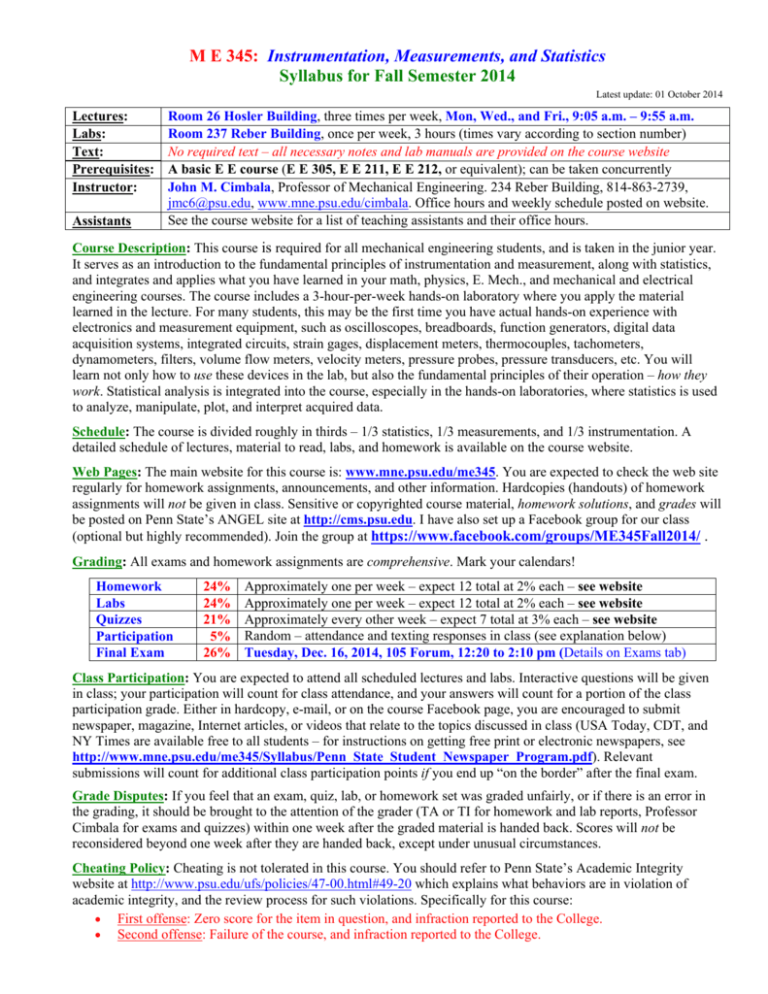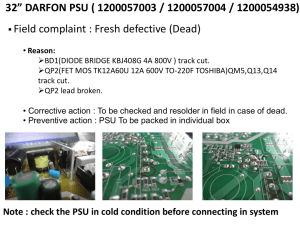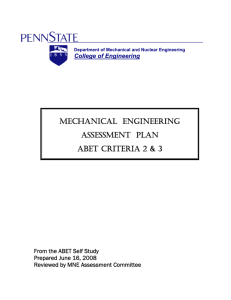M E 345: Instrumentation, Measurements, and Statistics Syllabus for
advertisement

M E 345: Instrumentation, Measurements, and Statistics Syllabus for Fall Semester 2014 Latest update: 01 October 2014 Lectures: Labs: Text: Prerequisites: Instructor: Assistants Room 26 Hosler Building, three times per week, Mon, Wed., and Fri., 9:05 a.m. – 9:55 a.m. Room 237 Reber Building, once per week, 3 hours (times vary according to section number) No required text – all necessary notes and lab manuals are provided on the course website A basic E E course (E E 305, E E 211, E E 212, or equivalent); can be taken concurrently John M. Cimbala, Professor of Mechanical Engineering. 234 Reber Building, 814-863-2739, jmc6@psu.edu, www.mne.psu.edu/cimbala. Office hours and weekly schedule posted on website. See the course website for a list of teaching assistants and their office hours. Course Description: This course is required for all mechanical engineering students, and is taken in the junior year. It serves as an introduction to the fundamental principles of instrumentation and measurement, along with statistics, and integrates and applies what you have learned in your math, physics, E. Mech., and mechanical and electrical engineering courses. The course includes a 3-hour-per-week hands-on laboratory where you apply the material learned in the lecture. For many students, this may be the first time you have actual hands-on experience with electronics and measurement equipment, such as oscilloscopes, breadboards, function generators, digital data acquisition systems, integrated circuits, strain gages, displacement meters, thermocouples, tachometers, dynamometers, filters, volume flow meters, velocity meters, pressure probes, pressure transducers, etc. You will learn not only how to use these devices in the lab, but also the fundamental principles of their operation – how they work. Statistical analysis is integrated into the course, especially in the hands-on laboratories, where statistics is used to analyze, manipulate, plot, and interpret acquired data. Schedule: The course is divided roughly in thirds – 1/3 statistics, 1/3 measurements, and 1/3 instrumentation. A detailed schedule of lectures, material to read, labs, and homework is available on the course website. Web Pages: The main website for this course is: www.mne.psu.edu/me345. You are expected to check the web site regularly for homework assignments, announcements, and other information. Hardcopies (handouts) of homework assignments will not be given in class. Sensitive or copyrighted course material, homework solutions, and grades will be posted on Penn State’s ANGEL site at http://cms.psu.edu. I have also set up a Facebook group for our class (optional but highly recommended). Join the group at https://www.facebook.com/groups/ME345Fall2014/ . Grading: All exams and homework assignments are comprehensive. Mark your calendars! Homework Labs Quizzes Participation Final Exam 24% 24% 21% 5% 26% Approximately one per week – expect 12 total at 2% each – see website Approximately one per week – expect 12 total at 2% each – see website Approximately every other week – expect 7 total at 3% each – see website Random – attendance and texting responses in class (see explanation below) Tuesday, Dec. 16, 2014, 105 Forum, 12:20 to 2:10 pm (Details on Exams tab) Class Participation: You are expected to attend all scheduled lectures and labs. Interactive questions will be given in class; your participation will count for class attendance, and your answers will count for a portion of the class participation grade. Either in hardcopy, e-mail, or on the course Facebook page, you are encouraged to submit newspaper, magazine, Internet articles, or videos that relate to the topics discussed in class (USA Today, CDT, and NY Times are available free to all students – for instructions on getting free print or electronic newspapers, see http://www.mne.psu.edu/me345/Syllabus/Penn_State_Student_Newspaper_Program.pdf). Relevant submissions will count for additional class participation points if you end up “on the border” after the final exam. Grade Disputes: If you feel that an exam, quiz, lab, or homework set was graded unfairly, or if there is an error in the grading, it should be brought to the attention of the grader (TA or TI for homework and lab reports, Professor Cimbala for exams and quizzes) within one week after the graded material is handed back. Scores will not be reconsidered beyond one week after they are handed back, except under unusual circumstances. Cheating Policy: Cheating is not tolerated in this course. You should refer to Penn State’s Academic Integrity website at http://www.psu.edu/ufs/policies/47-00.html#49-20 which explains what behaviors are in violation of academic integrity, and the review process for such violations. Specifically for this course: First offense: Zero score for the item in question, and infraction reported to the College. Second offense: Failure of the course, and infraction reported to the College. Program Outcomes, Course Objectives, and Course Outcomes M E 345 Program Outcomes Mapped to this Course: 1e. Statistics 2a. Analysis of mechanical components 2b. Analysis of thermal/fluids components 3a. Work effectively on multidisciplinary teams 3d. Communicate effectively with the written word 3f. Demonstrate professionalism in interactions with colleagues, faculty, and staff 4b. Learning in less structured circumstances 5a. Principles of measurements, instrumentation methods, and experimental design 5b. Exhibit a broad understanding of mechanical instruments and sensors, both in theory and practice 5c. Use appropriate statistical tools 5e. Make effective use of spreadsheets as an analysis and design tool 5g. Computer technology for report writing, presentations, and electronic communications Course Objectives: (Mapping to Program Outcomes is shown in brackets.) A. Understand basic statistics, and develop proficiency in the application of statistical tools. [1e, 5c, 5e] B. Understand digital data acquisition and spectral analysis of data. [5a. 5b. 5c] C. Understand basic electronics and circuit analysis for filters, amplifiers, and other signal conditioning circuits, and be able to build such circuits. [5a, 5b] D. Understand how to design, conduct, and analyze laboratory experiments, and how to properly report the results. [3a, 3d, 4b, 5g] E. Understand how various kinds of analog and digital sensors and instruments work, how they are calibrated – both statically and dynamically, and how they are applied in engineering. [2a, 2b, 5a, 5b] F. Advance proficiency in professional communications and interactions. [3f] Course Outcomes: (Mapping to Course Objectives is shown in brackets.) Upon completion of this course, students should be able to: 1. Apply statistical analysis to data samples to calculate mean, standard deviation, etc. and to determine the accuracy, precision, and sensitivity of sensors and instruments. [A, E] 2. Apply statistical and error analyses to measured data to identify and remove outliers and predict uncertainties. [A] 3. Apply linear and nonlinear regression analysis to perform curve fits to data and to determine correlation of variables and trends. [A] 4. Create histograms and probability density functions (PDFs) of data samples, demonstrate the ability to compare the results to standard PDFs such as the Gaussian and student’s t PDFs, and demonstrate the ability to predict probabilities based on the PDFs. [A] 5. Apply hypothesis testing techniques to both single variable and paired data samples to predict probabilities and confidence levels. [A] 6. Predict resolution, clipping, and aliasing when using digital data acquisition, and be able to generate frequency spectra using FFTs with and without windowing to determine the frequency content of a signal. [B] 7. Choose appropriate test matrices (design arrays), perform dimensional analysis, and design experiments that minimize cost and time. [D] 8. Build and analyze basic electronic circuits such as amplifiers, filters, Wheatstone bridges, etc., using resistors, capacitors, inductors, diodes, and op-amps. [C, E] 9. Apply differential equation analysis of first- and second-order dynamic systems to predict the behavior of sensors and instruments. [E] 10. Predict, analyze, and test the performance of sensors of various kinds, including strain gages, thermocouples, tachometers, displacement transducers, dynamometers, pressure gages and transducers, laser and Doppler velocimeters, pressure probes, and flowmeters. [E] 11. Demonstrate professionalism in oral and written communications with course instructors and fellow students. [F]








